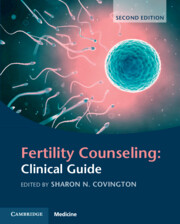Book contents
- Fertility Counseling: Clinical Guide
- Fertility Counseling: Clinical Guide
- Copyright page
- Dedication
- Contents
- Preface
- Contributors
- I Introduction
- II Therapeutic Approaches
- III Third Party Reproduction: Assessment and Preparation
- IV Addressing the Needs of Diverse Populations
- Chapter 15 The Male Experience with Fertility and Counseling
- Chapter 16 Counseling Lesbian, Gay, Bisexual and Queer Fertility Patients
- Chapter 17 Transgender Assisted Reproductive Technology
- Chapter 18 A Racially and Culturally Sensitive Approach to Fertility Counseling
- V Special Topics in Fertility Counseling
- VI Practice Issues
- The International Glossary on Infertility and Fertility Care, 2017
- Index
- References
Chapter 17 - Transgender Assisted Reproductive Technology
from IV - Addressing the Needs of Diverse Populations
Published online by Cambridge University Press: 24 November 2022
- Fertility Counseling: Clinical Guide
- Fertility Counseling: Clinical Guide
- Copyright page
- Dedication
- Contents
- Preface
- Contributors
- I Introduction
- II Therapeutic Approaches
- III Third Party Reproduction: Assessment and Preparation
- IV Addressing the Needs of Diverse Populations
- Chapter 15 The Male Experience with Fertility and Counseling
- Chapter 16 Counseling Lesbian, Gay, Bisexual and Queer Fertility Patients
- Chapter 17 Transgender Assisted Reproductive Technology
- Chapter 18 A Racially and Culturally Sensitive Approach to Fertility Counseling
- V Special Topics in Fertility Counseling
- VI Practice Issues
- The International Glossary on Infertility and Fertility Care, 2017
- Index
- References
Summary
Assisted reproductive technology (ART) is essential for transgender people’s reproductive justice and autonomy in relation to fertility preservation and family building, whether using their own bodies (eggs, sperm, or uterus), donor gametes, or a gestational carrier. The ability to form a family using one’s own gametes and/or body is necessary for transgender people to consider before medical transition is initiated (hormones/surgeries) and is part of the Informed Consent process of gender medical transition. Progressive thinking, greater cultural awareness and modern medicine have contributed to an increase in transgender people utilizing ART to create their families. Helping transgender patients navigate medically assisted fertility preservation and reproduction requires diverse knowledge, sensitivity training and cultural inclusivity for fertility counselors. Providing gender-affirmative care in reproductive endocrinology and fertility settings when working with transgender patients involves understanding terminology used in the transgender population, use of a trauma-informed care lens, knowledge of a nonbinary gender system, avoiding heteronormativity, cisnormativity and knowledge of gender dysphoria. The American Society for Reproductive Medicine (ASRM), The Endocrine Society, World Professional Association for Transgender Health (WPATH) and American College of Obstetrics and Gynecology (ACOG) have published documents addressing fertility and preservation considerations for transgender people.
- Type
- Chapter
- Information
- Fertility Counseling: Clinical Guide , pp. 172 - 182Publisher: Cambridge University PressPrint publication year: 2022



